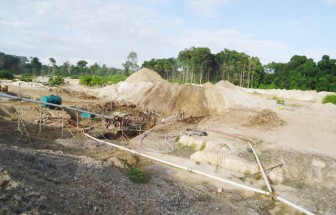– association urges self regulation,
enforcement of safety protocols
In an environment where there is a preoccupation with the lure of gold it is by no means uncommon for people to indulge in acts of recklessness without due regard to their safety and health, Guyana Gold and Diamond Miners Association (GGDMA) official Colin Sparman says.
In an interview with Stabroek Business on Monday, Sparman, who was a member of the investigating team into the October 3 pit cave-in at Aranka, where three miners were buried alive, said that while there is a health and safety regime that applies to the mining sector, some miners engaged in dangerous acts. He noted that the safety and health regime is administered by the Guyana Geology and Mines Commission (GGMC), but the recklessness of some miners, coupled with the lack of effective monitoring made the risk of accidents higher.

Sparman was prepared to respond to general questions relating to miners’ attitudes towards safety codes associated with the running of the industry and the effectiveness with which those codes are enforced, but said he considered it inappropriate to discuss the particular details of the recent Aranka accident.
Miners Devon Barry, 22, of Lot 22 Two Friends, Ann’s Grove; Deonarine Singh known as `Chubby’, 25, of Lot 17 Ann’s Grove and Elson Singh a 47-year-old father of three of Lot 1 Two Friends, Ann’s Grove died when the pit in which they were working caved in. A report arising out of the investigation into the incident was due to be out by Wednesday of this week.
Sparman was prepared to say, however, that indifference to safety procedures associated with the digging of pits was not uncommon. “In the old days, the equipment was less sophisticated and the pits were shallower,” Sparman said. “These days, the digging is being done by excavators so that when a hole gets to 15 feet and the structure is unstable it becomes dangerous.”
The GGDMA official said excavation activities in terrain where the substance is unstable may well require some measure of engineering advice and supervision, which is not always sought or secured. “The problem is that some miners are unmindful of rules and procedures. They work by repetition and sometimes without any guidance. Once you work that way accidents will happen,” he added.
The investigation into the Aranka incident was undertaken by a team that included representatives of the GGMC and the Ministry of Labour and Sparman said the report into the incident was likely to comment on a range of issues. Asked whether such reports usually comment on liability in case of loss of life, Sparman said that as far as he was aware, issues of that nature were usually handled bilaterally, between the families of the deceased and the owners of the mining operations.
Stabroek Business understands that one of the miners killed in the Aranka mishap was responsible for the ill-fated operation, having been allocated what is known in the industry as a “position” by the claim holder.
Meanwhile Sparman told Stabroek Business that while the association is a firm advocate of adherence to safety and health protocols, it was true that the welfare of some miners is often threatened by their own adherence to a culture of recklessness.
Former GGDMA executive secretary Edward Shields also weighed in on the safety issue in the wake of the Aranka incident confirming Sparman’s comments about recklessness on the part of some miners. This disposition, he said, was linked partially to difficulties associated with self-regulation on the part of the miners as well as to problems being encountered by the enforcement agency in ensuring the important safety and health regulations are honoured.




